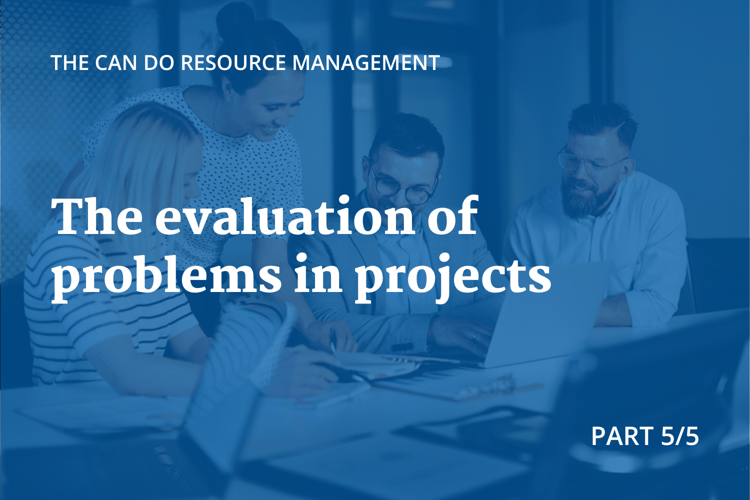When it comes to the human component in project management, problems are unfortunately not far away either ... Thomas Schlereth writes about the assessment and classification of project problems as well as suitable solution approaches. Also a topic in this last part of our blog post series is artificial intelligence in project management - and of course Thomas also draws a conclusion.
Can it get any worse? The evaluation of problems in projects
There are obviously good and not so good project managers - as practice shows. But what makes the difference? One essential aspect is the person's soft skills. How well can he or she motivate the team, how well can he or she organize? Is he or she professionally qualified and trained in project management methods, for example?
 In theory, a project is planned in detail and runs exactly as planned. If this were always the case, we would only need project planners, but no project managers. The team just looks at the plan and works through it without deviation. Anyone who has ever worked on at least one project knows that this is not how it happens: There are deviations of all kinds that lead to problems. The project management (or the team in an agile organization) then has to solve them. But before a solution is considered, the interpretation of the problem is crucial. This is where the good project managers differ from the not so good ones. Likewise, the good team leaders from the less good team leaders in a matrix organization.
In theory, a project is planned in detail and runs exactly as planned. If this were always the case, we would only need project planners, but no project managers. The team just looks at the plan and works through it without deviation. Anyone who has ever worked on at least one project knows that this is not how it happens: There are deviations of all kinds that lead to problems. The project management (or the team in an agile organization) then has to solve them. But before a solution is considered, the interpretation of the problem is crucial. This is where the good project managers differ from the not so good ones. Likewise, the good team leaders from the less good team leaders in a matrix organization.
A minimal overload is certainly a minor problem compared to a dramatic overload because a key resource gets sick for 3 weeks. Equally obvious, a problem in a time-fixed project, such as customizing software due to regulatory requirements by a deadline, is a bigger problem than in a low priority project. A risk in a project that has just begun may be rated lower than towards the end of the project, because there is more remaining time to compensate for the variance. The possibilities and assessments are complex, extensive and often influenced by personal motives and experiences. Many problems find their cause in cross-project resource planning - and why should one project manager change her project just because the other project manager made a mistake in planning?
Experienced and trained project managers can assess such situations very well and deal with them. What remains is the competition for resources in companies, where too much work always wants to be done in too short a time by too few people.
Solution approaches for the interpretation of problems
The interaction of the many parallel running work packages , whether agile or not, and the cross-project assessment of risks overwhelm people. Artificial intelligence can help here. This system analyzes the risk in terms of its negative implications and the scope of the risk. For this purpose, all conflict situations are considered and weighted both horizontally, i.e. on the time axis into the future, and vertically, i.e. ever deeper into the detailed project planning. The result is a generalistic recommendation as to whether anything at all needs to be changed in the planning or whether the project should be allowed to continue as it is for the time being.
Also, if a resource is mathematically guaranteed to be overloaded, the AI may come to the recommendation to ignore the problem. Here, the AI anticipates that the people in the projects also recognize the importance of work and projects and adjust their detailed behavior accordingly. Quite a few warnings then become much fewer where the AI recommends immediate intervention. The project manager can now focus particularly on these problems and is not distracted by trivial risks.
Can't the AI solve the problem itself right away?
So far, no.
The AI or a simple algorithm can calculate a constellation of work and people that solves the problem of an overload. But this could lead to virtually all projects being completely rescheduled. And that once per second.
Shifting a work package by one day with 5 assigned resources can trigger a cascade effect that adjusts 50 other projects and hundreds of scheduled work. Something like this is feasible in a project with an exclusive set of resources on the project; there are products that can do this. In a cross-project schedule, which includes vacation scheduling, it's impossible. The AI would then push the employee's vacation by, say, 3 months. This could be negative for the acceptance of the AI. Furthermore, the AI does not have all the information to determine a solution. Projects consist of deadlines, costs and above all quality, i.e. content. The machine cannot decide whether a planned operation can simply be realized with a little less effort (i.e. the quality can be reduced).
The human solution possibilities are still foreign to the machine. Encouraging and motivating the employee to achieve the goal after all, or directing his or her attention to important work, has been difficult or impossible for machines to implement up to now. This will certainly change in the near future when AIs have better access to people's personalities and also private data.
The project managers or the Scrum teams must therefore design a solution approach themselves. However, the software can strongly support them in this. Whether this conceived solution is feasible is subject to two primary, equally important aspects. On the one hand, the solution must be realistic in terms of its technical content, i.e., if the effort required to complete a task is reduced. Second, the solution itself must be feasible, i.e., the question "Does it really solve the problem if we reduce the amount of work by 30% in a work package or postpone the work package?" must be answered. This is a task that AI can take on.
If the software works in real time, it is a great help. The change is simply "tried" in the project plan. If the risk disappears, all is well and the solution can work. If not, an alternative or more advanced solution must be found.
Real-time in this context also means that the data available to the software is reasonably current and realistic. A project manager has few to no options to identify and solve problems if the team doesn't enter the actual sequence of work into the computer until the end of the month. The simulation of the machine has old data that is not current, so the result of the algorithms and AI will also not be resilient.
 That's why professional companies place so much emphasis on project staff updating work progress and quantity as daily as possible, at least weekly. Only then can the project manager(s) anticipate future risks thanks to the software and take preventive action. Interestingly, the employees who are the most overworked and stressed are also the ones who update their data the worst. This is a logical interaction that leads to an endless loop of problems.
That's why professional companies place so much emphasis on project staff updating work progress and quantity as daily as possible, at least weekly. Only then can the project manager(s) anticipate future risks thanks to the software and take preventive action. Interestingly, the employees who are the most overworked and stressed are also the ones who update their data the worst. This is a logical interaction that leads to an endless loop of problems.
However, the same correlation can also be observed and even statistically proven at the management level. The projects of those project managers who do not maintain their plans or simply ignore risks that the machine uncovers (factor hope) also cause the most problems in an organization, because they disrupt the other projects. However, these project managers are often also the people who complain the most and talk about challenges.
Conclusion: Is planning people in projects really that difficult?
The clear answer is: yes.
The reason is simple: we are talking about people, not machines. A clever project management methodologist coined a wonderful image here, which I'll steal:
Predicting the weather is essential for people. Harvests or travel are affected by it, to name just two examples. Since the dependency is very high, people developed methods early on to be able to forecast the weather. Indicators such as cloud formation, animal behavior or simply the probability of a weather event due to the time of year (April weather) were assembled into a model that was already quite good and resulted in simple principles such as farming rules.
But it was not until the development of satellites and the understanding of physical relationships that it was possible to develop mathematical procedures that significantly improved the forecast quality.
Here, a great deal of data is combined according to certain principles; this then results in a local or even global (climate) forecast. But even this forecast, calculated by high-performance computers with phenomenal software, is assigned a probability: "The probability of rain tomorrow is (...)".
The weather can also not be predicted to the day for the distant future; in good quality maybe 5 to 10 days. A longer period of time would only be predictable if the amount of measurement was much more accurate and likewise the calculation of the physical interactions much more accurate.
The sheer amount of computational operations and the constant change makes this currently still impossible. Just think of the image of the butterfly that could trigger a hurricane by a flap of its wings. So no one would expect the amount of rain in their backyard to be accurately predicted to the milliliter per square meter in six days.
It's a similar story with resource planning: it's impossible to predict exactly who will do what and when. Especially not the further into the future you look. But people are not completely blind either.
The future can be predicted in a certain degree of detail with a certain degree of probability. This is only possible with modern, almost intelligent software, which, in combination with the judgment of all acting persons, allows realistic target planning. A software like Can Do, which supports you in project planning and resource management with artificial intelligence.
We are happy if Can Do founder Thomas Schlereth, who wrote this and the four previous blog articles on resource planning, project planning and resource management, could provide you with valuable insights! You want to know everything about Hybrid Project Management, Can Do and Resource Management from a human perspective? Let us advise you without obligation - just get in touch!
Overview of our blog post series:
- Part 1: Is this chaos really necessary? Planning of people
- Part 2: What can PM software do?
- Part 3: Types of Project planning
- Part 4: The individual in resource management
- Part 5: The evaluation of problems in projects (this post)
Jetzt anmelden - Can Do Newsletter
As a member of the management board, Thomas is responsible for the operative management of the development including conception, design and further development of the software. He also advises customers on best practices and supports the roll-out.
Why Do Projects Fail? 5 Common Reasons - And How to Avoid Them
Projects are often complex, and even with the best intentions and a competent team, success can elude us. But why do so...
Cost-Cutting - Increasing Efficiency Without Additional Resources
Cost-cutting is currently at the top of the agenda for many companies. In the face of economic uncertainty and rising...
.png?width=200&height=80&name=CanDo%20Logo%20transparent%20(500%20x%20200%20px).png)


